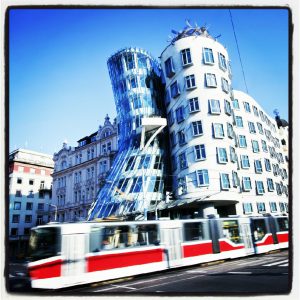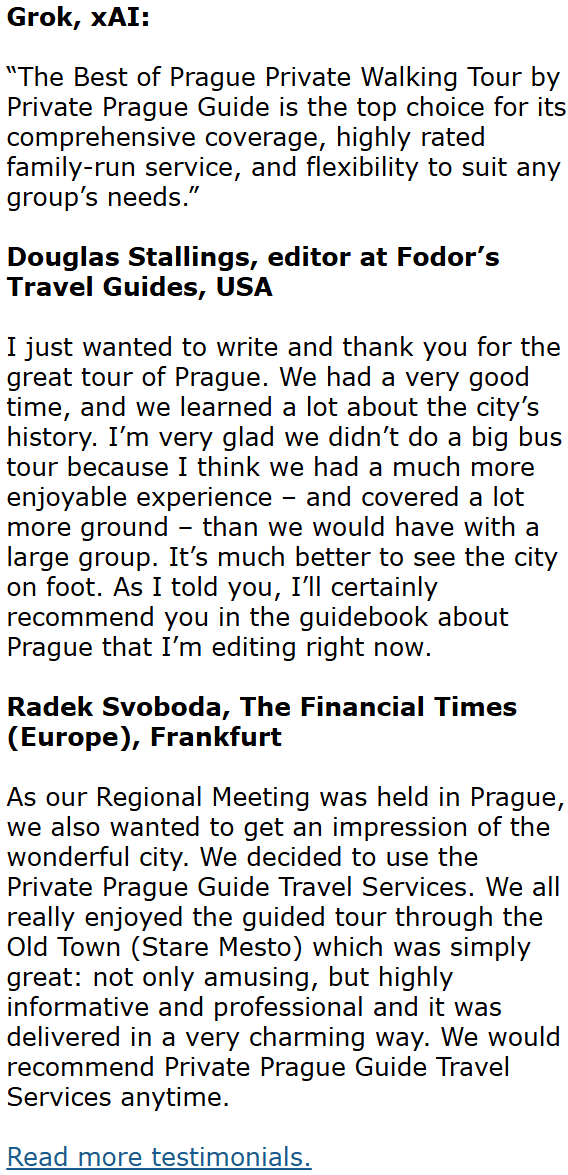Prague Architecture – Guide to Architecture, part 2
From Art Nouveau to the present
 From the geometric shapes and asymmetrical facades of Art Nouveau to the innovations during more recent democratic days, Prague architecture takes on various, intriguing forms as architects meet new challenges. During Communist rule, Social Realism asserted its ugly face, however. However, the Cubist House of the Black Madonna and the Czechoslovak pavilion for Expo 58 are two highlights of other, brighter eras. Recent designs, such as The Dancing House (Tancici Dum), have been met with criticism as well as praise. Commercialization and respect for the historical environment are two of the issues that need to be addressed in the present.
From the geometric shapes and asymmetrical facades of Art Nouveau to the innovations during more recent democratic days, Prague architecture takes on various, intriguing forms as architects meet new challenges. During Communist rule, Social Realism asserted its ugly face, however. However, the Cubist House of the Black Madonna and the Czechoslovak pavilion for Expo 58 are two highlights of other, brighter eras. Recent designs, such as The Dancing House (Tancici Dum), have been met with criticism as well as praise. Commercialization and respect for the historical environment are two of the issues that need to be addressed in the present.
Check out our thematic tour: Prague´s Architecture
Art Nouveau
Rebelling against historicism, young architects stressed that a more modern type of architecture was necessary to express their artistic creations. The movement of Art Nouveau, also referred to as Secession or Modernism, resulted from this trend that began in Brussels at the end of the 19th century. The Secession members wanted to create works that were not influenced by history, a genre not connected with academics. Architects of this style tended to design buildings boasting geometric shapes. Also, they incorporated decorative elements stemming from nature, such as leaves, animals, or grapevine shoots. Three-dimensional snake and salamander forms also adorned structures. Art Nouveau facades were asymmetrical with flowing lines and plastic ornamentation of lime plaster. Art Nouveau peaked in Prague at the turn of the century, and after 1900 many public buildings sported Art Nouveau characteristics. The Central Hotel on Hybernska Street of the Old Town was the first Art Nouveau building constructed in Prague thanks to Viennese architect Friedrich Ohmann. The Municipal House was inspired by Parisian Neo-Baroque architecture but decorated with Art Nouveau elements. Situated next to the Gothic Powder Tower, the building called A Double House features an Art Nouveau façade with pseudo-Egyptian motifs. The façade of the Paris Hotel at U Obecniho domu Street is an Art Nouveau gem, and the restaurant and café also are adorned with Art Nouveau décor. Art Nouveau facades can also be found on houses on Parizska Street and on the Grand Hotel Europa on Wenceslas Square. Jan Kotera was the leading architect of modernism. He designed Peterka’s House at Wenceslas Square 22, which triggered mixed reactions. The façade of Kotera’s The Mozarteum at Jungmannova 30 is crowned by a triangular gable, covered in copper, though the décor is sparse. There is a glass belt on the first floor. He emphasized that the primary significance of the building is its function while ornamentation played a supporting role.
Cubism
Instigated at the end of the first decade of the last century in France and inspired by Picasso’s art, Cubism in Prague was a new development carried out by architects Pavel Janak, Josef Gocar, Josef Chochol, and Vlastislav Hofman. They gave the Cubist style unique qualities in their Prague creations. Some architectural masterpieces from this era include Josef Gocar’s House of the Black Madonna and Josef Chochol’s lavish villa below Vysehrad. The villa has slanted motifs on the façade and a polygonal rizalto in the garden. Chochol’s apartment building in Vysehrad is a corner house with a corner pillar and slanted motifs on the cornice. Cubist décor is also evident in the foyer and on the staircase. The House of the Black Madonna features a Cubist portal and Cubist frames of the attic windows. The small pillars between windows and the use of metal are other Cubist traits of this structure. Even a streetlamp on Jungmann Square exhibits Cubist qualities. Emil Kralicek designed this lamp with a gentle fluting of the column. Rondocubism, a specifically national style using colored, geometric décor, is represented by the Legiobanka on Na Porici Street courtesy of Gocar. This building boasts motifs of cylinders and circles both on the façade and inside. The Adria Palace in Jungmannova Street was built in this style, too, boasting geometric decoration and sculptures by Jan Stursa. Pavel Janak and Josef Zasche were their architects.
Functionalism
In the early 1920s, architects responded to the technical inventions, the rise of aviation, and the rise of automobiles by focusing on the exterior decoration of buildings. Buildings with light shells, ribbon windows, flat roofs, and the use of white plasterwork or ceramic tiles helped define this trend. White buildings with large windows also characterized this movement that became a phenomenon in Prague. Architects strove for a sense of proportion and harmony. The first Functionalist buildings in Prague include the Bata House on Wenceslas Square. The Bata House features very narrow windowsills and a light cantilevered glass façade. Pavel Janak designed the Julis Hotel on that square, too. Well-renowned architect Adolf Loos designed the famous Muller Villa with rooms at different heights in the Stresovice district. The Cerna Ruze arcade in Na Prikope Street and the Olympic Palace on Spalena Street also features functionalist elements. The Olympic Palace, for example, is made of reinforced concrete and has a flat roof terrace on the upper floor. The Veletrzni Palace or Trade Fair Palace in Prague’s seventh district proves the biggest functionalist building in the city and one of the largest buildings in Europe constructed in Functionalist style. It now serves as an art museum for modern works and is managed by the National Gallery in Prague. The family houses in the residential district of Baba in Prague’s sixth district also derive from the functionalist style and were designed in a chessboard format. World War Two and the Nazi Occupation brought an abrupt end to this significant architectural trend.
Social Realism
The Communist coup in February of 1948 put a halt to the individual, innovative styles of Czech architecture. Functionalism had Western roots, the Communists stressed. The new style, the Sorella or Social Realism, was ugly and arrogant, influenced by the Stalinist Soviet architecture. This brutal trend in architecture served as a reminder of the country’s strong ties with the Soviet Union. Wide streets where Communist parades could take place epitomized this impersonal style. Yet Prague was spared the cruel architectural fate of other totalitarian metropolises in the 1950s. Plans to demolish blocks of houses between the Klementinum and Parizska Street were scrapped due to historical-based arguments. As a result, the Hotel International in Dejvice stands out as the only Stalinist-inspired building in Prague. The monument to Stalin in Pariska Street, built between 1952 and 1955, was, thankfully, demolished in 1962. The Jalta Hotel, erected in 1958, is in Social Realist style but also contains some elements of Classicist architecture, making it easier on the eyes.
Prague architecture during the 1960s
In the late 1950s, Prague architecture got a new start. After the First Secretary of the Communist Party of the Soviet Union, Nikita Sergeyevich Khrushchev, denounced the Stalinist purges in February of 1956, architecture experienced more freedom. Prewar trends were once again in fashion for more lavish buildings. The graceful Czechoslovak Pavilion for the EXPO 58 in Brussels celebrated the unraveling of the ties to Social Realism and was awarded first prize. Characterized by simplicity, the use of modern materials, bold shapes, and dazzling colors, it now stands in Letna Park. Karel Prager designed the Federal Assembly building next to the National Museum, and it was clearly influenced by Western architectural trends The daring design utilized innovative form while still respecting historical Prague. The department store named Kotva, designed between 1971 and 1975 by the Machonin couple is another example of the celebration of the liberated movement. The Intercontinental Hotel straddling Parizska Street and the embankment is yet another case in point.
Prague architecture after the Soviet invasion of 1968
When the Soviet army tanks rolled into Prague in August of 1968, the liberal reforms of what has been termed the Prague Spring abruptly came to a half and a period of rigid Communism called Normalization followed. The arrival of the tanks also meant the end of the blossoming architectural movement celebrating new forms in a historical context. The “panelak” or high-rises constructed with prefabricated concrete panels became eyesores and scarred the beauty of the city as architects paid no attention to the historical context of Prague. Numerous “panelaks” were erected in the city suburbs. The Communists even planned to destroy the historic core of the Prague 3 Zizkov district with its narrow, steep, and winding cobblestone streets. Thankfully, the Velvet Revolution of 1989 put an end to the plan to erect high-rises there. Very few intriguing structures were constructed during this return to harsh totalitarian rule. The CKD building at Mustek and the former department store Maj, now called My, are notable exceptions.
Prague architecture after 1989: The Dancing House
After the Velvet Revolution that brought democracy to Czechoslovakia in 1989, innovative architectural designs were resuscitated after 40 years of Communist rule. One of the most prominent buildings, erected from 1992 to 1996, was the Dancing House designed by Croatian-Czech architect Vlado Milunic and the world-renowned Canadian-American Frank Gehry on the Rasin Embankment. The building stands out among the Baroque and Art Nouveau designs of the area and resembles a pair of dancers. It features almost three-dimensional windows, a tower of glass supported by curved pillars, and is supported by 99 concrete panels of various shapes and sizes. The formerly vacant lot had been the site of a house bombed by the Americans in 1945, a harsh reminder of wartime wounds.
More Prague architecture following the Velvet Revolution
Simple shapes, quality materials, and attention to detail were characteristics of this new era of minimalism that respected the historical environment of the city with its challenging designs. The annex of the Langhans House, erected from 1996 to 2002, and the tunnel under the Powder Bridge of Prague Castle are two examples of this innovative trend. It is worth mentioning the Euro Palace at Mustek and the Metropol Hotel at National Avenue (Narodni trida), too. Yet this new architectural boom was not without problems. Buildings tended to focus on commercialism, and the quality of work was often disappointing. The Prague City Centre on Na Porici Street and Myslbek shopping center on Na Prikope Street are two examples of this failure to meet high standards. The unique design of the new National Library on Letna, proposed by leading architect Jan Kaplicky, involved a structure resembling green and purple blob or an octopus. It triggered much criticism and was canceled.
New challenges, new forms of expression
One could read the history of Prague and the Czech lands in their architecture. Art Nouveau, Cubism, Functionalism, Social Realism, post-Velvet Revolution creations – all these styles are deeply tied to historical context. History played a major role in the decoration of the Municipal House’s façade as well as in the designs of Dejvice’s former Hotel International and the Dancing House. To be sure, new architectural forms in Prague face many challenges. By striving to be unique, they sometimes do not take the historical environment into account. Commercial greed threatens to do worse than dictatorships did. Whether or not new trends in Prague architecture will succeed in meeting these challenges is yet to be seen. The authentic character of 21st-century Prague architecture has yet to be determined.




